Interesting Stuff
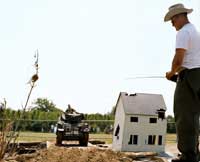 History will repeat itself. Strategies of Reenactment in Contemporary (Media) Art and Performance is probably the best exhibition i've seen this year. The show, which focuses on artistic strategies of re-enactment in contemporary (media) art and performance, has been set up by Hartware MedienKunstVerein, a platform for the production, presentation, education on and contextualisation of contemporary and experimental media art.
History will repeat itself. Strategies of Reenactment in Contemporary (Media) Art and Performance is probably the best exhibition i've seen this year. The show, which focuses on artistic strategies of re-enactment in contemporary (media) art and performance, has been set up by Hartware MedienKunstVerein, a platform for the production, presentation, education on and contextualisation of contemporary and experimental media art.
Gosh! was it good to be reminded that media art does not necessarily involve in-your-face interactive, flashy, entertaining installations (which i love except when they are nothing else than that.) This time, you have to sit down and engage with each work. Most of them are videos, usually not my favourite kind of media art but when the show is good, i sit down, shut up and enjoy. Not only is every single art work on display worth all your attention, but gathered in a single space they build up an intelligent and engrossing picture of what contemporary artistic re-enactments implies while providing you with many personal reflections about history, politics and society. There was way too many works for me to engage fully with so all i can do is look forward to see the exhibition again when it travels to Kunst-Werke in Berlin on 18 November 2007 - 13 January 2008.
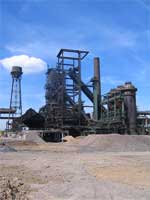
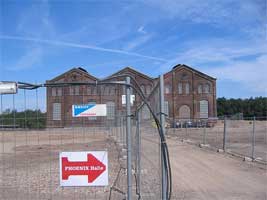
History Will Repeat Itself is located in the superb PHOENIX Halle Dortmund. Built in 1895, the three-aisle ex-factory is standing on the area of the former Phoenix-West steelworks in Dortmund-Hörde.
In general, a re-enactment is a historically correct recreation of socially relevant events, such as important battles or other historical events. In a re-enactment, the audience become immediate witnesses of a (repeated historical) event or they become participants in an action.
Unlike popular historical re-enactments, artistic re-enactments are not performative re-stagings of historic situations and events that occurred a long time ago; rather, events are re-enacted that are viewed as very important for the present. They question the present via repeating or re-enacting historical events that have left their traces in the collective memory, while at the same time pointing towards the fact that collective memory is essentially mediated memory.
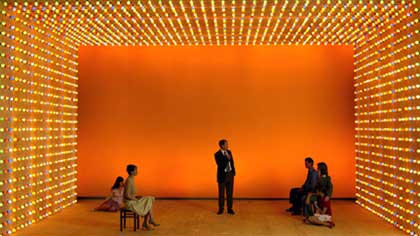
The most visible example of the power media has on memory is Unexpected Rules, by Frédéric Moser and Philippe Schwinger. On an empty stage, illuminated by coloured light bulbs, seven actors perform âThe Clinton - Lewinsky Affair: from 1995 to 1996.
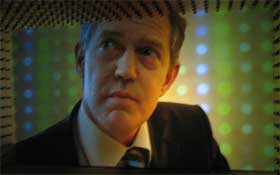 The affair, which was the HG of the media at the time,led to impeachment proceedings based on the report of the Republican investigator Kenneth Starr and a public apology of Clinton for lying.
The affair, which was the HG of the media at the time,led to impeachment proceedings based on the report of the Republican investigator Kenneth Starr and a public apology of Clinton for lying.
The re-enactmentâs script begins with the spreading of an intrigue and ends with the whispering of a lie, both by the character of the lawyer. In between, the story unfolds between Amanda (Monica) and Roy (Clinton), the lawyer, the Presidentâs family, and a secretary. Roy is shown as a victim of an intrigue out of political calculation, who only decides to perjure himself on the lawyerâs advice. The retelling of the event by the artists reveals the impossibility of arriving at a truthful analysis amidst the various interests surrounding the affair and their representation in the media.
Questions about the power of media to shape our memories and vision of an event get even more acute with Jeremy Dellerâs The Battle of Orgreave.
 The movie recreates the violent clash between the Thatcher government and the British National Union of Mineworkers in 1984â"1985, near the coking plant of Orgreave in South Yorkshire.
The movie recreates the violent clash between the Thatcher government and the British National Union of Mineworkers in 1984â"1985, near the coking plant of Orgreave in South Yorkshire.
After three years of intense research, Deller recreated the âbattleâ in 2001 with the help of âre-enactmentâ groups, miners, and policemen who participated in the event
Because the reports in the media at the time were strongly influenced by the government, and the workers and trade unions were described as âthe enemy withinâ (Margaret Thatcher), Deller did not use contemporary media reports. Instead, he used the memories of the protagonists â" miners and policemen alike â" as the basis of the re-enactment, correcting the (distorted) image projected by the media is corrected.
The re-enactment and the documentary, which film director Mike Figgis made for Channel 4 (he combines scenes of the re-enactment of 2001 with photographs of the clashes of 1984), generate a new and different practice of the histthe historicisation of recent, still sensitive English history, which remains relevant today for existing political and social conflicts.
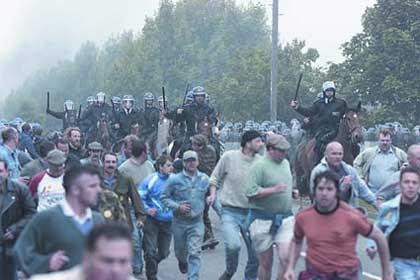
Two videos you might want to have a look at: 1 and 2.
The exhibition is on view until September 23, 2007 at the PHOENIX Halle Dortmund.
Photo credit: image on top left corner is from Heike Gallmeier's series of photographies taken at the War & Peace Show; first image of Unexpected Rules (Fundación Bienal de Sao Paulo); B&W photo of Battle of Orgreave by Don McPhee (found in The Guardian) All my images.
Related: The Port Huron Project, a series of reenactments of protest speeches from the New Left movements of the 1960s and '70s.
Can't believe that it was only last month that i was in London to blog the RCA Summer Show. Finn Magee graduated from Design Products' Platform 8 with a series of lights that i found fascinating. They reminded me of Paper Clock by rAndom international*.
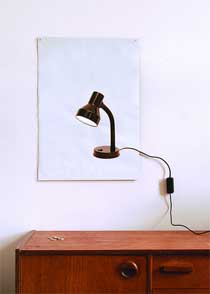
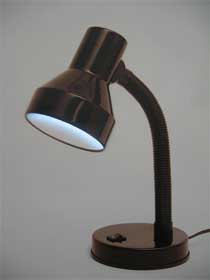
Flat Light (image on the left courtesy of the designer)
LED in the poster illuminate the printed lamp or alarm clock. Finn bought standard electronic components off the internet and then mounted them behind posters, letting the light come through.
What were the challenges you met while working on the project?
It was really interesting trying to find the right objects for the portraits. All the products I used were similar to the cheap electronics that were around my house as I was growing up. Other than that I just tried to keep the whole product as simple as possible, letting the paper do the work to hold the cables running behind the poster and staying away from using picture frames or any custom parts as I want them to be easy to produce and buy.
Any plans to develop the lights further or market them?
The Flat Light is in development with Artemide, which has been a pretty interesting experience. Some UK design companies have approached me regarding the Flat Time Clock, which is positive, as I kind of prefer this project and wanted to get it into production.
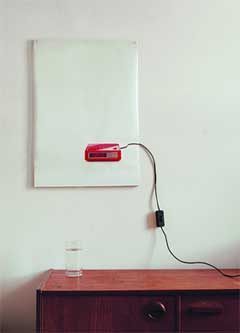
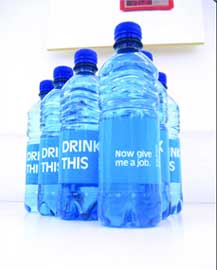
Flat Time and CV Water (both images courtesy of the designer)
Finn was also showing some CV Water bottles. The project investigate advertising techniques of surprise, juxtaposition and saturation. These ad-objects aim to question our interaction with the images we consume.
What about the water bottles?
The water bottles are tied in with my other projects as they all explore advertising techniques of surprise and subversion. So instead of giving out business and postcards I decided to sell my contact details, by including them in something that people need, Water! Unfortunately the aircon worked really well in the tent so people werenât as thirsty as I hoped, but I cleared most of them anyway!
Thanks Finn!
Images.
* (Hannes Koch from rAndom is running the platform together with Gabriel Klasmer btw.)
- Scientists breed world’s first mentally ill mouse - Times Online
Worldâs first schizophrenic mice in an attempt to gain a better understanding of the illness. Until now they have been bred only for research into physical conditions such as heart disease. - Lead us not into cyber-temptation as missionaries enter Second Life -Times Online
Father Spadaro urges Catholics to go out into the simulation game of Second Life, to lead the cyber-embodiments of their fellow men and women out of the many temptations that exist there. - emily’s playground
ompendium of people, places, ideas and things Emily Davidow love (or at least noticed). that girl's got good taste - b l o g . F A B R I C A: Type the Sky
Type the Sky was born from an instance of sky gazing in the middle of Barcelona from the narrow streets in between several buildings. An intersting cross between photography and typography - Bestiality May Be Knackered In Second Life
The Second Life Herald asks whether adults dressing up like animals and partaking in virtual sex with each other or with human shaped avatars (virtual bestiality) constitutes broadly offensive behavior. - Bottles of "Pet Sweat" water
- Décès de l'acteur Michel Serrault dimanche soir - 20minutes.fr
- Biocampus - free public conference Art and Biomedicine: Beyond the body
free public conference Art and Biomedicine: Beyond the body will give voice to the people practicing in this field â" artists, biomedical practitioners, exhibition curators, art historians, art teachers and funders - Conflux Festival » Make a Video Public Comment to Save Street Photography
New regulations from the Mayorâs Office on Film set absurd restrictions that would require you to have a permit, and a million dollar insurance policy. Fight back! - E-Flux The third Glasgow international Festival of Contemporary Visual Art
will run from 11 - 27 April 2008. The Festival continues to provide a platform for the best in contemporary visual arts as well as commissioning new work. Curated by Francis McKee.
N=1=NPK=KIMCHI=N, a project by visual and performance artist Jae Rhim Lee, is a mobile living unit which consists of a urinal, urine processing system, hydroponic napa cabbage garden (which uses mineral nutrient solutions instead of soil), seedling growing area, a foam bed in the shape of her body, and a kitchen table.

The artist undertook the task to grow food using her own urine, with her body acting as a filter to maximize nutrients for growing the cabbage. She first sent her urine to a floriculture lab, followed a customized vegan diet designed to transform her urine into the ideal nutrient solution for plants.
She then used the resulting cabbage to cook kimchi and fed her colleagues and gallery visitors from the living unit.
With N=1=NPK=KIMCHI=N, Jae Rhim Lee synthesize concepts of the self-body, narcissism, death, and ecology to arrive at a methodology for the long-term preservation of the self and planet.
PDF of the research project.
Via capsula.
Related: Wim Delvoye's Cloaca.
Over the past year, i've spent an impressive amount of time ogling a blog called Variable_environment. It had all the key ingredients that get my attention: pictures (many, lavish, big, most of them snapped by Milo Keller), inspiring collaborators (including architect Philippe Rahm, multimedia designer Ben Hooker, researcher and designer Rachel Wingfield and architect Christophe Guignard), mini robotic guest stars, and great content. The blog posts document a fascinating research project called Variable environment/ mobility, interaction city & crossovers. The project starting point is the fact that our living environment and the way we live have tremendously changed over the past few decades. The postmodern city made of signs and infrastructures that Robert Venturi and Denise Scott Brown have described in the '70s in their book Learnings from Las Vegas, have been progressively "enhanced" by new layers: more signs, spaces and objects, arrival of new technologies, increasing mediation of our relationship to space, intensification of transport.
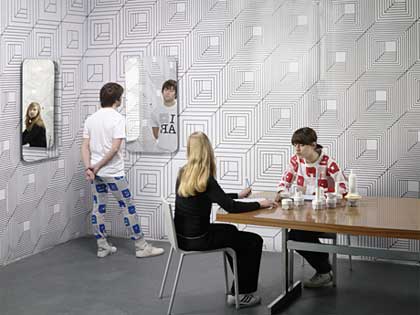
Variable environment/ is a research project that explores the new challenges faced by our living environment, focusing on interaction design as well as architecture and environment design.
An activity report has been recently published that details the Variable_environment/ project. Selected images and texts have been entirely drawn from the blog and reorganized to allow a linear reading of the project. You can download a pdf version of it (161 pages mixing french and english.)
I contacted Patrick Keller and asked him to give me the lowdown on variable_environments/. Patrick is responsible for the coordination and art direction of the project but he is also one of the founder of fabric | ch, a studio for architecture, interactions and research, and a teacher at ECAL.
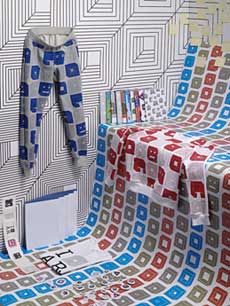 You wrote on the blog that "the interdisciplinary challenges and themes relating to the creation of contemporary environments should be tackled through a collaborative efforts of designers (interaction design, design product and graphic design), architects and scientists. This transversal approach hardly ever happens in Switzerland and Europe." Why do you single out Switzerland and Europe? Have you seen examples of interdisciplinarity and collaboration between design, architecture and scientists in other countries or continents?
You wrote on the blog that "the interdisciplinary challenges and themes relating to the creation of contemporary environments should be tackled through a collaborative efforts of designers (interaction design, design product and graphic design), architects and scientists. This transversal approach hardly ever happens in Switzerland and Europe." Why do you single out Switzerland and Europe? Have you seen examples of interdisciplinarity and collaboration between design, architecture and scientists in other countries or continents?
Well, I shll, I should first say that I had to single out Switzerland because the project was done in the teaching and research context of Switzerland (the texts in the blog are the same ones that I snail mailed to the experts who funded the research): the Variable_environment/ project was linking the two high-schools of ECAL (Ecole Cantonale d'Art de Lausanne ---Arts & Design---) and EPFL (Ecole Polytechnique Fédérale de Lausanne ---Sciences, Architecture & Engineering---), which was kind of a new education situation in Switzerland.
But this small country can in fact be considered as a good representative for the rest of Europe though (regarding education in design, architecture and sciences, there are quite good high-schools in Switzerland like ECAL, HGKZ, Accademia Mendrisio, ETHZ & EPFL) and especially because like in most of Europe, art & design disciplines (at the exception of Architecture) are usually taught in different schools, structures and locations (and btw with less money) than the rest of disciplines at university level like humanities, engineering, life sciences, etc.
Christophe Guignard and I did a round trip two years ago for ECAL, visiting lots of schools and universities in Europe and United States to see what kind of collaborations were going on between designers and scientists. So for example there is a clear difference between the way Design is being taught in Europe and in the United States or Canada: most of the big universities in the US (Stanford, Berkeley, UCLA, Harvard, MIT, Columbia, etc.) include Art, Design and Architecture schools on their campuses. This should allow for a common knowledge of the work of each other, a sort of base on which you can start, but it also mainly allow for potential easy collaborations on a daily basis. Of course, it is not because it is possible that people are taking advantage of it... Curiosity is still needed in this context because it is usually not part of any regular teaching cursus at the moment.
So, in a more general way, I should say that no, these kinds of collaborations are unfortunately not so usual yet (but I don't know the situation in Asian countries which might be different). They still remain more related to the work and initiatives of individuals, but it's naturally increasing though and will soon become a necessity and an evidence I think.
Architecture is a bit different, it has now a long history of collaboration with engineers: since the modern period and the industrial revolution, it's teaching has left the art schools and integrated the Universities nearly everywhere. Mainly all good architectural schools (with some few exceptions) are now part of big universities or polytechnical schools. In this sense, what has been done with this particular discipline and its teaching in the early 20th century could serve has a reference for some areas of contemporary design, even if the architectural field should also clearly rethink and instigate its relations to other disciplines now.
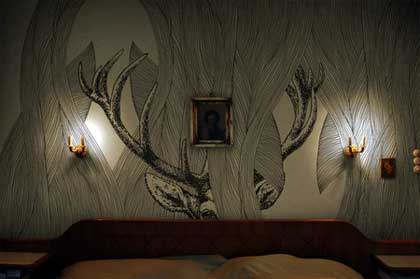
Lunatic Room by Eric Morzier & Camille Scherrer
Which challenges does such inter-disciplinary element face? Do you think that it would be easy for scientists, architects and designers to find a common language and work in synergy?
I don't really believe in the model of the "designer-coder" who would be formed in a design or art school. Design and code, these remain two different formations where different skills are needed if you want to reach a high level, unless you are ready to study in high-schools for 10 years to reach a Master level. But on the other side, it's hard for those disciplines to work together because the rhythm of work is quite different, especially in a research context. So what could be the solution?
Of course, it's now absolutely necessary that designers understand code and scripting, because design happens also at the level of code nowadays. And in a more general way, it's important that designers are regularly confronted and include/understand the works of scientists because major transformations of societies are now happening through the applied impact of scientific researches and developments, often without the (critical) input of designers. But I also think that it's absolutely necessary that each discipline keeps its edge and profile, its own goals (or lets say its own difference) so that collaboration can be rich. And that's true for any type of collaboration, might it be design and life-sciences, architecture and nanotechnology or whatever. Some collaborations are nowadays experimental (i.e. Architecture and life sciences), some are no more but were it hundred years ago (i.e. architecture and civil engineering that has built most of our contemporary landscape). So, those we need today in the transversal areas we are interested in are designers that understand code/some sciences and engineers that understand design, a common knowledge and then highly creative and critical collaborations of any type between them.
For this, the way we teach and the structure of teaching in Europe should me modified because we will never reach this common knowledge while keeping the high-schools in design and sciences separated as well as their budget so different.
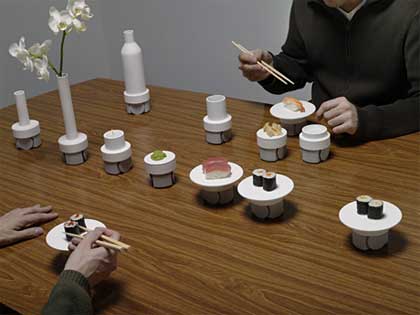
Rolling microfunctions by Patrick Keller, Julien Nembrini, Christian Babski, Julien Ayer and Laurent Soldini
Could you tell us a few words about the AiRtoolkit and in particular about one of its application the "AR ready" project?
The AiRtoolkit project has three facets I would say: first one is the redesign (with interaction design considerations) of a known open source software (ARtoolkit, a marker based augmented reality application), second one are the " AR ready objects" while third are some uses you could have as an end user with such a software coupled with the "AR ready" objects. Each facet of the project is not so particular in itself. It is when you think about combinations of the three that it gets exciting.
When you think of a technology like the (now old) desktop computer, you usually think and focus on what you see, the screen and its content. You think less about what you don't necessarily see anymore: the way it has modified your daily working environment. As an exemple, think about the typical office table: the computer has "aspired" many objects into the screen (the famous "office" metaphor): pictures of relatives, music, mail, etc., finally even the table, that has been replaced by your own knees! Most of those objects or supports are now into the "black box", non material anymore. But what you have "gain" are hundreds of plugs and cables, a whole in the table to make way for them, a "bag" under it to hold them, headphones, remote controls, etc. So to say, a technology could be considered as the thing in itself and all its potential "collateral effects".

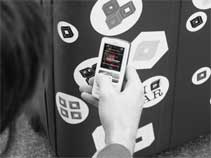
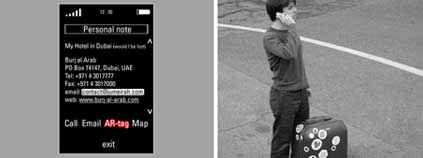
"mnemonic suitcase" with stickers and private text-based information
"AR ready objects" are about these "collateral effects": the marker based Augmented Reality technology induces invisible/digital content (usually 3d) that you'll only see through the live eye of a mobile camera (would it be a cellphone camera or a hi-tech headset), on top of what this camera is capturing. But to see this invisible or "augmented" content, you'll have to put a visible marker in the physical environment. That's in fact what we thought was interesting in this technology (beside the possibility to mix the physical and the digital): to put a visible sign to say that there is something invisible, something you can't see with your eyes and that there is an all new visual and functional level that can only be reached through the vision of your camera. We were interested to examine how such a strange environment might look like visually and redesign or distort many known objects that would use this visual language for cameras. We knew at that time that AR technology without markers was under development, but we thought that keeping the markers was a more interesting approach for the physical environment.
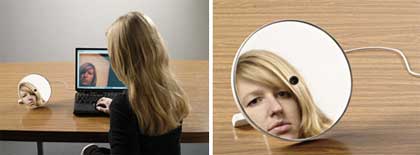
Aude Genton's (web)cam objects
Don't you fear that our environment is getting too techno-mediated?
"Techno-mediated" is a subset of "mediated" and man probably maintains an increasing mediated relation to its environment since the time he built tools, his first shelter or cultivated its first seeds. He has put the natural environment "at a distance" and still tries to format it (or literally "inform" it) according to its needs, even if he fortunately still has to deal with natural conditions due to the limited energetic resources he can get.
Therefore a car, a house, a cellphone, a plane, a virtual environment, a space station, air conditioning, a computer, a tool, language, agriculture, etc., can all be considered as mediations to environment as well, or to inhabitable space, other humans, etc.
I agree with you that the mediations to environment are definitely increasing and that they get now for some decades "techno-mediated", provoking lots of perceptive interferences (with time, distance, location, relation to climate, etc.). These existing interferences created by those techno-mediations bring new design areas and challenges where designers could potentially work with time, distance, instant, climate, etc. and where, as architects, we are interested to work into (at least that's the area of work which we are exploring the most now with fabric | ch, the architecture, interactions & research agency I'm working with).
Is it getting too mediated already (I wouldn't make a distinction with techno-mediated)? I will tend to answer by the affirmative: any mediation has an energetic cost and we can all witness that there are energetic problems now and a clear negative impact of energy consumption on climate and natural environments, therefore on our fair existence as a group on this planet. This "climatic alarm" is probably a first strong sign telling us that we are living with too many mediations to our environment, mediations that consume too much energy (at least if we don't find new and cleaner sources of energy).
This is rapidly becoming another design challenge, at least for architecture (I mean, do we really need to live with A.C. all the time in offices? do we need to heat all rooms of our homes all day long in winter time when we spend just a couple of hours into them? do we need so many different mono-functional and space consuming rooms? do we need this and that?).
We'll need to redesign our relation to environment with less (techno-)mediations at less energetic costs, or maybe rather with variable densities of mediations over time and situations.
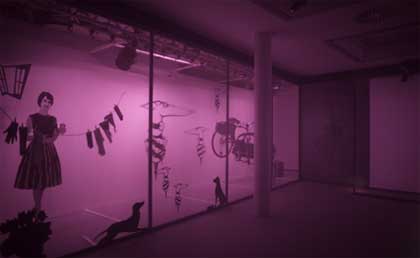
Angelo Benedetto went to Milan and checked out a spectacular exhibition i missed
Are you optimistic about the future of the "interactive" city?
The "interactive city" is with no-doubt already here, even if it's not looking so "sci-fi" at the moment or even remains quite hidden in fact. Shopping, transportations, banks, communication, voting, state management, etc. are already interactive-like experiences, even if most of them are consumer-driven, profiling and very functional experiences. At the moment, the interactive city is getting built mostly by the private market (and therefore private interests), a bit by the state and a bit by engineers. Nearly no architects or designers are involved in the conceptualization and realization of big public projects (at least I haven't heard of it, please let me know if I'm wrong). This probably also because most designers and architects are a bit conservative and remain kind of blind to contemporary stakes or don't get enough involved into it.
Anyway, I think that the "interactive city" will increase, still mostly driven by private interests at first (so no, I'm not so optimistic about its future). The "real" will certainly become more and more digitalized when all kind of computers, sensors and actuators will enter the building and urban design economy (see for example the ZigBee Alliance like consortium). Then we will get an enormous amount of data from these sensors (and to whom will belong those data, captured by which programs of which companies ---proprietary or open-- will become a big question!)
The city and buildings will probably first start to "speak" (i.e. "too hot" or "too many people" here, "too much traffic" or "too poluted" there, etc.) allowing for some kind of automated tasks, which is not a very interesting approach. But then, these data and spatial computing will also allow for crazy architectural projects and an all new condition for the contemporary space we will live in.
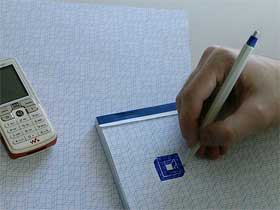 Do you plan to develop the VE project any further?
Do you plan to develop the VE project any further?
Variable_environment/ was a first research project between ECAL & EPFL with a special goal in mind: to make a first collaborative test and collect informations before the opening of a brand new EPFL-ECAL Lab. This laboratory will link permanently the two schools in the new big building that is getting renovated for ECAL in the west part of Lausanne, Switzerland.
So, from next October, this lab will be open and collaborations between the schools will increase. All kind of collaborations between design, architecture and sciences will be possible among many teachers and students (there will be no initial thematic limitations). Engineers from EPFL will follow courses in design (object, graphic, interactioneraction), before, hopefully, designers start to follow some courses in computing and sciences.
The Variable_environment/ research has mainly served this "big picture" project for research and education in Switzerland. But in itself, the project will surely continue within this new academic context even if many opportunities are still open at the moment and if we don't know exactly which ones will go further yet (we might go to preproduction with the (Web)Cameras, continue to work on the "AR-ready" Objects and the AiRtoolkit and/or do a European research project as a big extension to what has been started with the Rolling Microfunctions (in collaboration with the Royal College of Art / Tony Dunne).
Thanks Patrick!
Photo credit: Milo Keller, ECAL.
Participants of the Variable_environment/ project: Aude Genton, Tatiana Rihs, Bram Dauw, Adrien Rovero.
- vintage_ads: happiness
they are happy because they eat... - Sangmin Bae--RhythmFish, a device that explores biosonic and infrasonic sound.
Video capture is combined with the data from flow sensors inside the tank (measuring currents caused by the fish's swimming patterns). These inputs are combined to create audio and video output. - Normalising paranoia at fulminate // Architectures of Control
a catalogue accompanying a specially printed newspaper designed to be used with rose-tinted spectacles: Feeling brave? Read the paper as usual. Feeling fragile? The spectacles block out bad news stories which are printed in the same hue as the lenses so i
Camera Silens (1994) is an installation for one user at a time a completely sealed-off chamber equipped with a dentist's chair and a closed-circuit surveillance system.
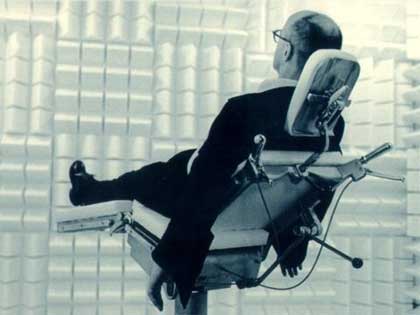
The work refers to a research project at the university clinic in Hamburg Eppendorf, which was suspended in 1973 due to outraged public discussions. Psychiatrist Jan Gross and his colleague Peter Kempe had set up 3 years earlier a "Camera Silens", an anechoic and nearly soundproof chamber, to conduct investigations of the effect of "social isolation and sensory deprivation" on both healthy test persons and patients at the psychiatric hospital under conditions of total separation from natural surroundings (as wikipedia says [citation needed]).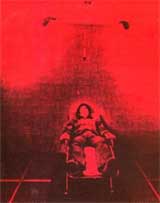
Artists Olaf Arndt and Rob Moonen copied this "Camera Silens" to refer to experiments involving the complete control of the human consciousness.
The reference to the theme of sensory deprivation allows connections
to be made to the solitary confinement of prisoners, as well as to various methods of brainwashing. It indicates the possibility of regarding the human brain as a hard disk in a metaphorical sense, which can be deleted and re-written.
Related: Art Oriente Objet's
- Design & Punishment chair - fulminate // Architectures of Control
by Ben Cunningham. the chair progressively collapses as the userâs home energy use becomes excessive, and restores itself when corrective action is taken (such as turning devices off): - In pictures: Stirling Prize
the contenders for the £20,000 Royal Institute of British Architects (Riba) Stirling Prize - Yhancik Magazine - Inside beauty
Disassembled videogame controllers, by garyflixer - SPAWN OF THE SURREAL - art projects in second life
Travel notes of an art critic lost in the dumpster of the imaginary - Elvis in Berlin
exhibition from mid august to early sept - Beyond the Beyond - RFID at the beach
visitors will wear wristbands that debit their bank accounts or credit cards to pay for beach access, food and parking. Garbage cans will e-mail cleanup crews when they are ready to be emptied. Beach checkers could scan the sands with handheld devices and
Last episode of the Biorama day in Huddersfield where Capsula and the Digital Research Unit had invited artists to present the way their work explores and blends notions of life, science and digital realities.
Biorama (Part 1) + Biorama (Part 2)

France Cadet, just back from an interesting-looking conference about theatre and robotics held in the framework of the 61st Festival d'Avignon, explained how she hacked robot dogs (she used I-Cybie which doesn't come with a software like the Aibo, therefore re-programming the robot is a long and complex process) and turned them into transgenic and chimerical animals inspired by the advances of (bio)technology, in particular cloning experiments. Each robot raises questions about possible accidents, animal and human behaviour, artificialisation of life, side effects of cloning, dangers of xenotransplantation, etc.
Video
COPYCAT is half dog, half cat. It is independent and clean like a cat while being affectionate and playful like a dog. The robot was inspired by "Cc" the first kitten cloned in December 2001 at Texas A&M university. The breakthrough has made it possible to clone your favourite dying or dead pet and to produce a pet "Ã la carte".
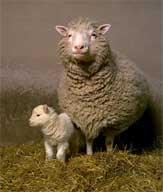
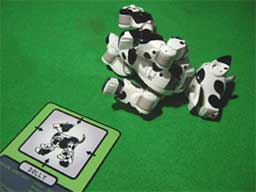
DOLLY has a more complex origin, half of it is a dog, then it is 30% ewe, 15% cow and a tiny portion of sheep. The dog is named after Dolly the sheep, the first mammal cloned in 1996. Both sheep and bovines specimens have encountered difficulties for their cloning: BSE: Mad Cow Disease, Progeria, premature ageing (because her donor sibling was six years old when the genetic material was taken from her, Dolly may have been genetically six years old at birth), abnormal size and various pathologies. This species aims to cure all the side effects of cloning and deterioration of DNA. However, not everything went according to plans and the dog-cow is suffering from BSE and eventually dies on its little pad of artificial grass.
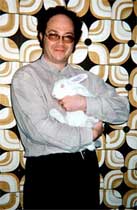
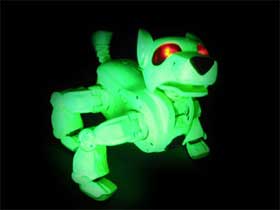
GFP PUPPY had just 1% of Green Fluorescent Protein gene transferred into its genome. GPF is present at the natural state in jellyfish, and commonly used to mark the cells. In this case, the gene gave the dog a phosphorescent coat. After the fluorescent mouse and Eduardo Kac's Alba rabbit. "GFP Puppy" marks the beginning of a new age of animal cloning, that of more evolved and complex species.
XENODOG is half dog, 45% pig and has also 5% Nude gene.
While the pig is smart and sociable enough to make the perfect pet, it is also the best species to supply organs for xenotransplantations. XENODOG has also the same genetic defect as the nude mouse that prevents him from growing hair and from immunologically rejecting human cells and tissues.
JELLYDOGGY. This genetic mutant is 90% dog with 5% jellyfish and 5% chameleon. 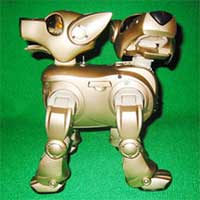 Its genome has been enhanced with the gene of a hydrozoan (jellyfish family) as well as the gene of the chameleon, well known for blending in with his environment. This peculiarly enables him to adapt to an aquatic life.
Its genome has been enhanced with the gene of a hydrozoan (jellyfish family) as well as the gene of the chameleon, well known for blending in with his environment. This peculiarly enables him to adapt to an aquatic life.
SCHIZODOG has worryingly been "enhanced" with 25% Dr. Jekyll genes and 25% of Mr. Hyde.
The cloning experiment helps increase our understanding of psychological disorders such as multiple or split personality disorder, bipolar disorder, schizophrenic disorder... it also makes us aware of genetic influence on the psychology of twins, Siamese twins and clones. The study of the two headed dog may suggest promising forms of treatment and perhaps, in the near future, may help predict the outcome of several mental illnesses.
Along with the dog genes, the FLYING PIG is 40% pig, and has 5% nude and 5% human genes.
Inspired by Stelarc's extra ear, Symbiotica's Pig Wings and the nude mouse with a human ear attached onto its back. Initialy designed to serve as a model for tissue and cartilage engineering and to replace a missing or malfunctioning part of the body, those ear-wings prosthesis, made out of muscles, soft tissue and flexible cartilage, can actually enhance the bodyâs fonctions. From now on reconstructive surgery belongs to the past, time has come for augmented surgery.
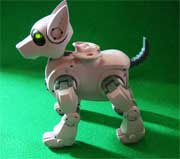
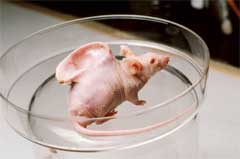
The last presentation of the day was from etoy agent Marcos who briefly recalled TOYWAR the most successful performance of the group. Toy retailer eToys.com sued etoy for having a similar domain name to their own (etoy.com.) They first offered incresingly big sums of money to get the domain and when they realized it wasn't to sell, they decided to launch a rather dirty legal battle. After several weeks, a market capitalization loss of $4.5 billion dollars, eToys dropped the lawsuit and the etoy website returned to operation.
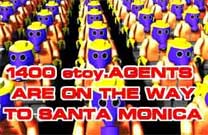
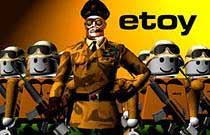
But Marcos was mostly there to talk about MISSION ETERNITY, an ultra long term project started by etoy.CORPORATION in 2005. Its theme is the cult of the dead in the digital age, its chore idea is to create a digital portrait and make it eternal it through a p2p system and its main pilar is the arcanum capsule.
Video summary.
The ARCANUM CAPSULE is reserved for charismatic pioneers of the information age: the Mâ PILOTS (the process can not be offered to the broad public yet as it is too artistically intense, expensive, and requires the participation of a whole range of trained etoy.AGENTS). So far only 2 TEST PILOTS are in the pipeline (microfilm pioneer Sepp Keiser and writer Timothy Leary).
The Mâ ARCANUM CAPSULES contain digital fragments of the life and âsoulâ of the USERS and enable them to maintain a presence post mortem as data particles hosted in the shared memory of hundreds of networked computers and mobile devices such as cell phones of the so-called Mâ ANGELS, people who contribute a part of their digital storage space to the project. As long as humanity exists and people are connected, the memory will be preserved.
Now how can you make the remains eternal in a more tangible way? By having them enter some art institution through physical artefacts. They would get from the family ash once the pilot has died and incorporate it into sculptures called Mâ BRIDGES that link physical and memory spaces as well as life and death. Innovative technology and artistic quality might appeal to art collections, libraries and museums. Conservation would thus be outsourced to protected environments and experts financed by governments, foundations and private collectors. The ash of the deceased would be mixed with cement and then used as dead pixel on the big screen inside the sarcophagus.
The first series of Mâ BRIDGES are dominated by visual output (SARCOPHAGUS and MISSION CTRL) and close to traditional art forms. The second series will be based on antenna principles: broadcasting radio signals (voices of Mâ PILOTS), WLAN, Bluetooth and cell phone content. They will introduce a new generation of public interactive art.
- Elit Alice » Pac-Man crocheting
- *Window | Interface* at Mildred Lane Kemper Art Museum Aug. 31 to Nov. 5
Exhibition will highlight artistic projects that explore the roles of windows and interfaces as both boundaries and sites of transaction between machine and mind, data and perception, the world of the body and the world of the imagination. - World Monuments Fund Unveils 2008 Watch List of 100 Most Endangered Sites
This yearâs list highlights buildings and other heritage sites that are threatened by political conflict, unchecked development, and, for the first time, climate change. - How to Book a Cheap Flight - Mahalo
- le cool * Milano
mostra Balkenhol alla pac - le cool * Milano
MOSTRA Hannah Dougherty - microRevolt reBlog: Trade & War in Columbia
'Spread the word that U.S. aid and trade should alleviate the humanitarian crisis in Colombia, not support a military solution to problems arising from political, social, and economic inequalities." - Pasta&Vinegar » Using ; Using movements from real sharks in a digital game
players control their ships, but the sharks are controlled by real-world white sharks with GPS units. Real-world telemetry data provides the position and movement of sharks in the game, so every shark that players encounter corresponds to a real shark in - Mr. Watson » Maverick Machines
Maverick Machines, an exhibition inspired by the work of Gordon Pask, opened in Edinburgh this week. wanna go
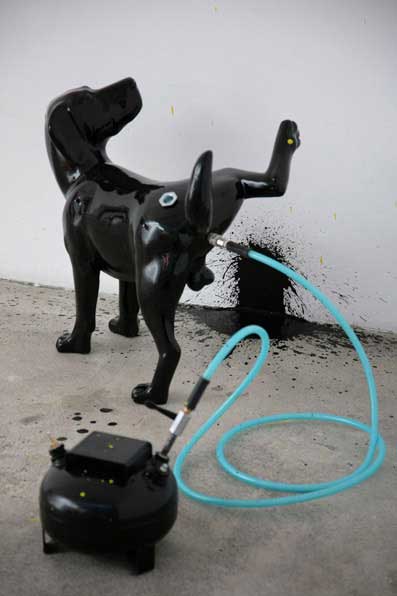
Detail from The Dining Room by Richard Jackson, a staunch friend of animals.
Check out The Dining Room and The Maid's Room (video explanation) until 31 July. at the Galerie GP and N Vallois, in Paris.
Via gogo paris.
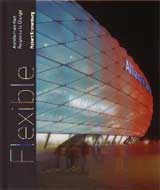 Flexible, Architecture that Responds to Change, by Robert Kronenburg.
Flexible, Architecture that Responds to Change, by Robert Kronenburg.
(Amazon USA and UK
.)
Editor (Laurence King Publishing)'s blurb: Flexible architecture adapts to new uses, responds to change rather than stagnating, and is motive rather than static. Understanding how it has been conceived, designed, made, and used helps us understand its potential in solving current and future problems associated with technological, social, and economic change. This book explores the whole genre of flexible architecture buildings that are intended to respond to evolving situations in their form, operation, or location. Crossing the boundaries between architecture, interior design, product design, and furniture design, this innovative book is the first to deal with the entire scope of the topic.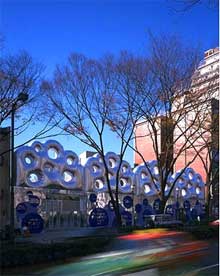
The hologram of a football stadium on the cover of a book that deals --among others-- with responsive architecture! I was not sure at all whether it was a genius idea. The image does get your attention though but it also shouts "hey, i'm hip and a bit superficial". Fortunately the content of Flexible is nothing of the latter. And it is not any football stadium anyway.
The author, Robert Kronenburg, while he began working on the book in 2000, has actually been exploring the topic for two decades and it shows. The book is well-researched, precise and it encompasses all the aspects of flexible architecture: geographical, chronological and cultural. Although Kronenburg never hesitates to go into technological details, the explanations are always clear and easy to grasp. None of that puts too much strain on your grey cells yet you feel like you're getting much smarter with every page you turn. Me likey!
It's also one of those books you enjoy either by just flipping through to have a peek at the images and discover projects you had never heard of or by reading it religiously, from page 1 to 231.
The first part of the book goes beyond the swanky interactive screens and explores the historical, cultural and social context that has shaped contemporary design and architecture. Mobility reflects human civilization's tendency towards change and is nothing new, especially if you take a look outside our static Western culture... think about the Yurt or the traditional Japanese home with its tatami and flexible items of furniture that can be moved around to better respond to the inhabitants' needs and which probably have them engaged in a more meaningful way with their dwelling.
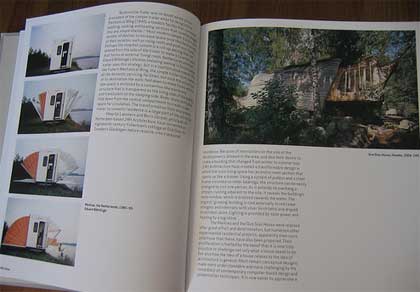
Inside the book
The second part is organized around 4 key factors that characterize flexible architecture: Adaptation (to better respond to various functions, uses and requirements of the buildhe building), Transformation (with alterations of the the shape, volume, form or appearance of the building), Movability (an important aspect when you think that a building is one of the most immovable artefacts of our culture) and Interaction. The chapter about interaction encompasses both the inside and the outside of the house. The use of intelligent systems, whether automatic or intuitive, in architectural practice owes a lot to researches from other fields, in particular the automotive industry. That interactivity might be guided by many factors that range from the need to control the use of energy to a mere desire to change the appearance of the building by the overlay of changing images and patterns.

Inside 24H Architecture's "accordion" house
Image on the right side is Pika Pika Pretzel, by Klein Dytham architecture.
Related: Book review: Responsive Environments: Architecture, Art and Design.
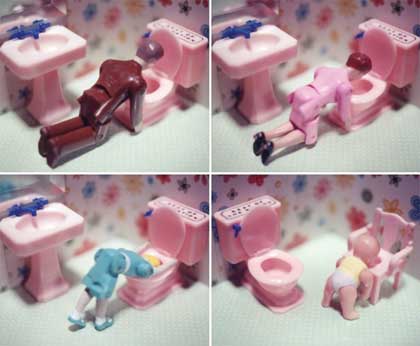
Davis & Davis, The Ralphs (Dad, Mom, Baby, Sis) 1999
Part of the exhibition âDangerous beauty â" Bellezza pericolosaâ, PAN â" Palazzo delle Arti Napoli/Naples, until Oct 23, 2007.
Via teknemedia.
More domestic bliss: the hairy family, the fetish one, the one in stockings
- The Bauhaus Archive / Museum of Design presents Berlin Settlements from the 1920s
25 July - 8 Oct. 2007. Berlin possesses a rich architectural heritage in the form of residential developments dating from the period of the Weimar Republic. These settlements are not only exemplary works of modern architecture, but also bear witness to th - Ars Electronica Katalogartikel
Bio Artâ"Taxonomy of an Etymological Monster (jens Hauser) - ARTnews - Messaging the media
review of an exhibition about artistic uses of 'new media' - Archinect : Features : Blue Monday
Kazys Varnelis interviewed - Cool Hunting: Angela Singer
much of her recent artwork is made from discarded hunting trophies and other taxidermy that strives to illuminate human exploitive tendencies of the rest of the animal kingdom. - Gothamist: Andy Bichlbaum, Cultural Activist
interview of a Yes Men man - Drug users to get shop vouchers
Drug users are to get shopping vouchers if they stay clean and take part in treatment programmes - Boing Boing: Trailers from Hell: directors muse on schlocky movie faves
Each Monday, Wednesday, and Friday, there's a new video segment in which a renowned movie director comments over one of their favorite b-movie / exploitation / grindhouse flick trailers. - silenzio - torino, fondazione sandretto - Exibart.com
Silenzio Torino, Fondazione Sandretto - Renzo Piano - Le citta visibili
La Triennale di Milano presenta Renzo Piano Building Workshop. Le città visibili una grande mostra monografica sullâopera di Renzo Piano - INSTANT URBANISM
link with the show on the Situationist International at the Tinguely Museum, by drawing upon the propositions made by the Situationists with relation to transforming architecture and city spaces. - CIAC's Electronic Magazine - Net art v1+2.0 - Genesis, figures, situations
As a result, the works of art produced there are multifarious-environments to be navigated, programs to be executed, forms to be altered-and sometimes go so far as to include the possibility of adding to or altering the initial artistic material. - graffonic by 3kta
Electronic Graffiti system using Video Tracking and a Laser Pointer, that's able to generate RGB images.
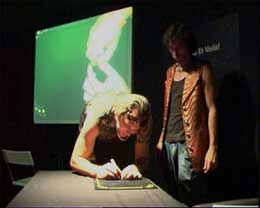 opensourcery is what you get when you throw a master of bewitching installations and a "real" magician right into a workshop dedicated to magic and illusion.
opensourcery is what you get when you throw a master of bewitching installations and a "real" magician right into a workshop dedicated to magic and illusion.
The workshop was Interactivos?, it took place in June at the MediaLab Madrid. The illusionists are Zachary Lieberman and Mago Julián ("Julian the Magician" in english.)
opensourcery is a performance which marries camera based technology with old fashioned close magic to manipulate a live video image seamlessly and create new tricks. The custom developed software is completely open-source (thus the title) and designed as a starting point for imagining a new language of tricks and techniques for magical expression.
A few questions to Zack:
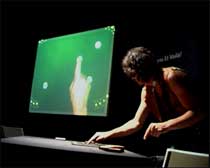
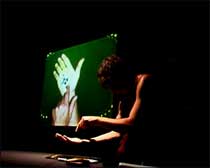
The coin follows the finger, then moves on its own + The magic eye reveals the chosen card
I suspect that it was the first time that you worked with a magician. How did the collaboration go? Did Mago Julián come with an idea asking for some technical help or did you develop the whole concept together? And did he teach you a few tricks you plan to use in your future work?
First of all the collaborate came out from the excellent advice of José Luis Vicente and Oscar Abril, two Sonar curators who noticed a similarity between how my performance Drawn works and how the magician Mago Julián uses an overhead camera to perform close magic.
It was the first time I've ever worked with a magician, and it was really surprising to see the differences in how we work and make work.
For example, magicians are very secretive about their techniques - it took a long time for Julián to warm up to showing me some of the "behind the scenes" while we were working together. I still have absolutely no idea how he does many of things he does live. In contrast, I was eager to demonstrate all of the techniques and hidden systems that make the projects I've worked on, like Drawn or Manual Input Sessions work.
Since we didn't have a lot of time to develop the project during interactivos, we started with Drawn, and he spent some time learning and performing with it. I also spent time examining his close magic performance, and learning about the kinds of things he might need in a performance. What was amazing is that his magic is so good, he really doesn't need any help with technology, so it was a very nice starting point. We started to identify needs - for example, to take a snapshot of an object and reveal / hide that snapshot when it is covered, so that his act can have a certain amount of freedom. I recoded a great deal of Drawn (in order to make a clean, open source project) and we spent a lot of time just playing with different effects and ideas.
An amazing thing that happened was that Mago Julián and Punkie (his wife and partner in the act) started completely hacking the software. They would take different bugs or problems and flip them into remarkable tricks. Every day I would come to the workshop and Julián would be like, "We have to show you this!" The last trick, for example, when Julián reveals the card through a magic eye was completely based on bugs in the rendering. I cringed the first time he showed me (as a programmer I hate to see those bugs) but the cringe quickly became a huge laugh.
Video (excerpt) of the performance at Sonar / SonarMática 2007:
How does opensourcery work technically?
It's software that is programmed in C++, using the openframeworks library, that takes a live video image and composites it with synthetic graphics and then reprojects the results to create something which is seamless and looks just like live video. The software is based on Drawn, and is completely open-source.
During the performance a second operator (in this case the Magician's wife) works backstage to control the software, but it could be programmed to work with wireless devices or switches.
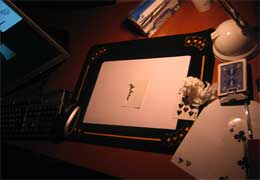 Do you plan to go any further in the development of this piece?
Do you plan to go any further in the development of this piece?
Yes, one of the nice outcomes of the Sonar performances is that we have been invited to several Magic festivals. For me this is very exciting because while I typically work in new media festivals, I have never even been to magic festival, let alone performed in one. We are going to develop several new tricks and refine the current ones.
Additionally, we have made the software completely opensource, and we will be making in early fall a manual and tutorials available so that anyone who wants to perform these tricks (or develop new ones) should be able to. We look forward to other people participating or using the software. While a magician almost never reveals his tricks, we want to do the exact opposite.
Thanks Zack!
*Previous episodes: I Thought Some Daisies Might Cheer You Up, Delicate Boundaries, Palimpsesto and Augmented Sculpture v 1.0. Interview with Marcos GarcÃa from MediaLab Madrid.
- Day La Marseillaise became the new anthem of Belgium - Times Online
where is guy? - Nerve gas antidote made by GM goats
Scientists have genetically modified goats to make a drug in their milk that protects against deadly nerve agents such as sarin and VX. - coin-operated » PleaseSpam.Us - Collaborative Voting For Spam-Worthy Addresses
a web based collaborative filtering and voting system. people submit email addresses with reasons to persuade other users to vote on whether those addresses are worthy of attracting spammers. - Wooster Collective: JR and Blu Together in Berlin
hat am i doing out of berlin again?? - Video of the nightingale poo facial
- Cabinet Magazine Online - Not a Happy Fraction of a Man
"phantom limbs"
Back to my notes from Biorama, a one day event organized by Capsula and the Digital Research Unit on July 13 in Huddersfield. The event brought together an exciting bunch of artists whose work explores notions of life, science and digital realities.
Laura Cinti (who is currently doing some research on the way plants can be modified in order to be visually responsible to touch) and Howard Boland from c-lab (interviewed then a few months ago) focused mainly on their fascinating Martian Rose project.
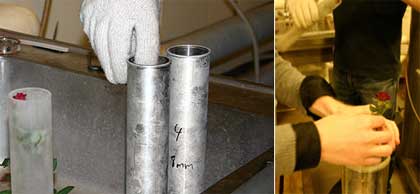
How would the aesthetics of the flower start to break down if exposed to the Mars environment? Would it still have petals? The project started as a very romantic idea: offering a rose to Mars. They worked with scientists from the Mars Simulation Laboratory, at the University of Aarhus in Denmark.
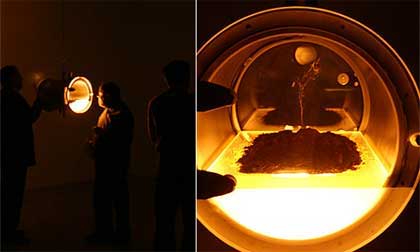
The artists and the scientists put roses inside a vacuum chamber built to simulate parameters such as temperature, gas and distribution, pressure and radiation.
Bacteria can go into suspension and survive after exposure to extreme environment, they will event produce new patterns. The roses, however, were not too happy with the experiment. After several hours of exposure the flowers were significantly darker in colour. As they warmed up, they would easily collapse having been exposed to low pressure.
One of the roses is currently exhibited at BIOS 4, a show on biotechnological and environmental art at the Centro Andaluz de Arte Contemporaneo in Seville, Spain.
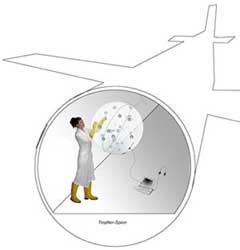 After Laura and Howard, it was the turn of Agnes Meyer-Brandis to present her work. I had her talk about her projects a few months ago, so i decided to drop the pen and paper and just enjoy her witty talk full of iceberg drifting along the Brazilian coast, elves and other mysterious phenomena. Agnes is currently working on her latest project the Cloud Core Scanner, an artistic experiment in weighlessness within the scope of the German Aerospace Center's parabolic flight campaign.
After Laura and Howard, it was the turn of Agnes Meyer-Brandis to present her work. I had her talk about her projects a few months ago, so i decided to drop the pen and paper and just enjoy her witty talk full of iceberg drifting along the Brazilian coast, elves and other mysterious phenomena. Agnes is currently working on her latest project the Cloud Core Scanner, an artistic experiment in weighlessness within the scope of the German Aerospace Center's parabolic flight campaign.
Brandon Ballengée discussed his transdisciplinary approach towards increasing environmental awareness, how he sees his work as an interface between biological research and a much more ch more experimental programme.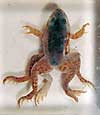
Brandon has spent the past decade studying amphibians which he defined as the "environmental canaries in the coalmine." They act as bio-sensors. Studies have demonstrated that amphibians are declining even in protected environments. Reports of discovery of frogs which are born with more or sometimes less than 4 legs. With such deformities, the animals have very little chance of survival and the phenomenon might partially explain the decline in amphibian population. Such reports emerged mainly from the US. But declines and deformities of amphibians probably exists on 6 continents. The New York-based artist is currently spending several months in the UK to have a closer look into declining amphibian species, through participatory lab and field-based research investigations. The project is organised by The Arts Catalyst and enabled by residencies at Yorkshire Sculpture Park, Gunpowder Park, and SPACE. He not only works together with scientists but also organizes âeco-actionsâ fieldtrips that involve members of the public in his research projects.
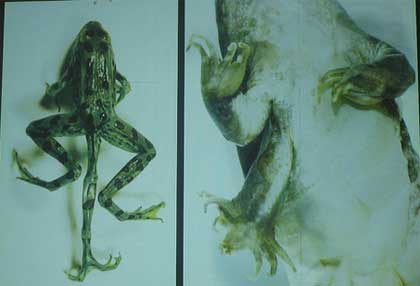
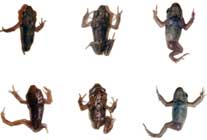 One hypothesis that might explain amphibian deformities is that some parasite inside the body of the frog might hamper its normal development. When amphibians are mutating, they are very sensible to the environment. Brandon made experiments where he would cut one limb of the frog at different stage of its transformation and see it regrow until a rather late stage. If a parasite gobbles its way into the transforming tissues of the mutating frog, it would form a cyst and impede the normal growth of the limbs. The organism of the frog would try to compensate and grow an extra tow or an extra leg coming from the same tissue. This phenomenon of extra limbs is increasing and it compromises the immune system of the amphibian.
One hypothesis that might explain amphibian deformities is that some parasite inside the body of the frog might hamper its normal development. When amphibians are mutating, they are very sensible to the environment. Brandon made experiments where he would cut one limb of the frog at different stage of its transformation and see it regrow until a rather late stage. If a parasite gobbles its way into the transforming tissues of the mutating frog, it would form a cyst and impede the normal growth of the limbs. The organism of the frog would try to compensate and grow an extra tow or an extra leg coming from the same tissue. This phenomenon of extra limbs is increasing and it compromises the immune system of the amphibian.
Brandon has discovered in North Yorkshire many amphibians with just one leg or no leg at all, this phenomenon is not described yet in England. The artist documents the deformities by creating hi-res images using a flat-based scanner (he built an aquarium on top of it).
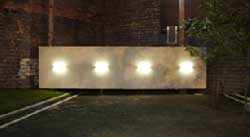 Another of Ballengée's project, the outdoor installation âLove Motels for Insectsâ, enables the public to study arthropod diversity in urban and natural areas. A blank canvas and ultra-violet (black) light enable the study and photography of arthropods (spiders, moths, beetles, etc.) and other nocturnal creatures. Attracted to the light, the creatures mate and feed on the sculpture. It is a "place for bugs to make more bugs." Moths release chemical pheromones to attract mates and consequently "paint" the piece, while spiders spin webs adding their own contribution to the work.
Another of Ballengée's project, the outdoor installation âLove Motels for Insectsâ, enables the public to study arthropod diversity in urban and natural areas. A blank canvas and ultra-violet (black) light enable the study and photography of arthropods (spiders, moths, beetles, etc.) and other nocturnal creatures. Attracted to the light, the creatures mate and feed on the sculpture. It is a "place for bugs to make more bugs." Moths release chemical pheromones to attract mates and consequently "paint" the piece, while spiders spin webs adding their own contribution to the work.
Brandon uses eco-projects to raise awareness of ecological issues and have people feel part of it. C-lab has a couple of very good images of Brandon Ballangee's work.
- Popoholic- Video Viewer- Entourage Medellin Video
- apartment hunting :: hyperexperience
voyeur is an on-line interactive that lets you spy on an apartment building, unit by unit, as strange things seem to happen involving the residents. - Interactive Architecture dot Org » Performative Ecologies - Ruairi Glynn
so called âinteractive environmentsâ rarely enable the architecture to negotiate its behaviours , but follow pre-choreographed routines (...) a great deal of misuse of the term âinteractiveâ is common in art, design and architectural discourse - biotechhobbyistmagazine
"The place on the Web for biotech tinkerers, builders, experimenters, students, and others who love the intellectual challenge and stimulation of hobby biotech !" - Scotsman.com News - How monkeying around with diet affects reproduction
BABOONS in Nigeria are consuming natural contraceptives which, for around three months of the year, prevent females getting attention from males and falling pregnant. - Where are the gels who can talk proper and pirouette? - Times Online
next generation of British actors just cannot speak proper. The rise of âEstuary Englishâ has left children with the intonation patterns of Lily Allen and Jonathan Ross, regardless of their background. - hannah dougherty - milano, studio d’arte cannaviello - Exibart.com
Hannah Dougherty - Joint effort: Robotic ankle research gets off on the right foot - MIT News Office
Army veteran who lost part of his leg in Iraq unveiled the world's first robotic ankle -- an important advance for lower-limb amputees that was developed by a team at MIT. - www.Bioject.org » Blog Archive » Photophobes
Little analogue circuits are just like me; they cry when approached to sunlight⦠The only way to stop it is to cover it with something or put it in the shadowâ¦
Today's easy reading:
Robbits, by Susanna Hertrich and Matthias Melitzki, aims to explore emotional qualities of interactive objects by inviting a human audience to interact play with »electronic creatures«. Robbits works as an installation consisting of a community self- and location-aware mobile robots.
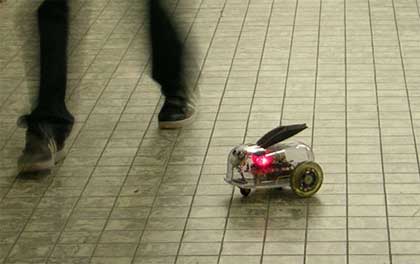
Video, via bunnylicious.
Let's rabbit: PCBunny, The Coniglio Hat, myBio bunny, A field of inflatable rabbits, This must be designed by idiot.
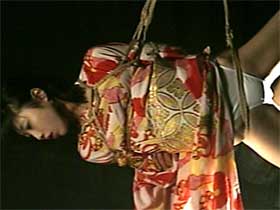 I arrived last week at Documenta in Kassel pulling my suitcase along the bumpy pavement with one hand, while the other was busy crossing its fingers "Let's hope there is less video art than at the Venice Biennale!" Turns out that there is an acceptable proportion of videos at Documenta, some of which are worth mentioning:
I arrived last week at Documenta in Kassel pulling my suitcase along the bumpy pavement with one hand, while the other was busy crossing its fingers "Let's hope there is less video art than at the Venice Biennale!" Turns out that there is an acceptable proportion of videos at Documenta, some of which are worth mentioning:
In 1987, film director Hito Steyerl was 19 and agreed once to be a model for a bondage photo shooting in Tokyo. Lovely Andrea (dubbed "A La Recherche du Cul Perdu") narrates the search for that photography in the Tokyo bondage scene. Helped by self-suspension performer and guide Asagi Ageha, Steyerl and her team find the image in a sex archive and set out to meet the photographer. Along the way, people interviewed talk about freedom, shame (that "libido of the brain") and tell stories such as thch as the habit at the time of tricking young girls to bondage photo studios under the pretense of offering them some other kind of job. Once there the girl was so frightened that she worked for free, the promise that the men would let her go was enough of a reward. The plot is intertwined with images of performances by Asagi Ageha. While watching images of the performance, i never thought of sex, perversion or pain, just elegance, lightness and sheer beauty.
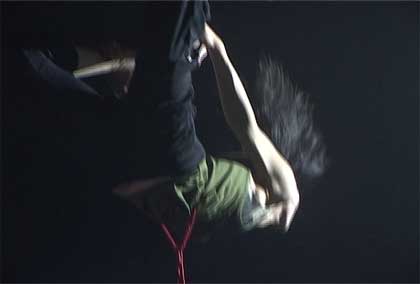
The lost photo shows the artist half naked and tied up, a bondage picture in the nawa-shibari style, characterised by women bound and suspended in the air. Today Japanese bondage has an unmissable sensual and erotic dimension. But it developed from the martial arts, Hojojutsu being the art of restraining a person using cord or rope.
It seems that a trailer (all i could find was this little interview with the artist) as kinky as befits the subject was available on the website of Documenta 12 before the opening of the exhibition, it was soon removed "due to terms of use violation.â The press and blogosphere immediately suspected that Documenta organizers were just looking for a cheap PR coup.
"But in a wider context, there is bondage all over the place", the video states at one point. In fact, the work entangles images of Japanese bondage girls with superheroes Spiderman and Spiderwoman (found those a bit easy cheesy) but also bound captives in the US-detainment camp at Guantanamo Bay. And pop music, there is a lot of pop music.
As i wrote there are videos all over the place, yet this room was one of the very few which was always packed. Sex has you sit for hours.
Images from Documenta presskit and HR online, more pictures of Asagi Ageha in TokyoBound.
Danielle Wilde describes her latest project, the hipDisk, as being possibly the most undignified musical instrument ever. hipDisk exploits changing relationships between torso and hip to actuate sound. Video 1 and 2.
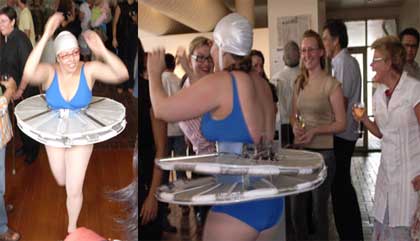
Simple horizontal disk-shaped extensions of the body exaggerate the interdependent relationship of the hip and torso. Soft switches, strategically placed around the perimeter of each disk, allow the wearer to play a chromatic scale, and thus simple melodies, restricted only by flexibility and speed of swing.
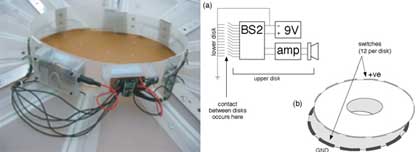
In creating hipDisk, the interest was to move beyond limb- and digit-triggered switches and explore full-body movement for actuation.
Ultimately, three iterations of hipDisk will be developed so that a small orchestra of hipDisked women can play chord structures together, or harmonize and so accompany voice or another solo performer/player. A version of the instrument may also be developed for men. Yes, please, please Danielle, do make a version for lads!
Danielle lists in her paper (PDF) the various projects that hipDisk builds upon and relates to. Here are just a few of them:
- the interface is related to Kei Kagami's Head Holder (2006), a dress that explores dynamic structures by means of rods and strings that cause exaggerated movement of the garment by the motion of the model or wearer,
- the output of hipDisk is related to Danielleâs previous work Ange, which allows the player to trigger sound samples and control volume, so mix up to 24 samples in real-time, simply by manipulating their volume,
- the input/output relationship is also simple and direct, the tones triggered through core-body gesture, allowing us to make a correlation to physical interfaces like Dance Dance Revolution.
Also by Danielle Wilde: the periscope, the musical ribcage and the Dress.
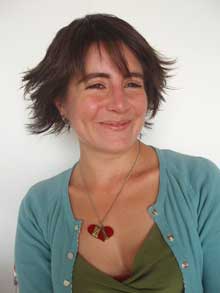 Last month i was in Colombia for (and thanks to) the Pixelazo festival.
Last month i was in Colombia for (and thanks to) the Pixelazo festival.
I then asked Alejandro Tamayo if he could point me to any artist worth meeting in Bogota. Several names came to his mind but when i had a look at the images of Adriana Salazar's machines, i just said "Stop! Stop! no more names, how can i get to meet her?" How could i not want to know more about a girl who creates delicate and elegant (but slightly ludicrous) machines that smoke, tie shoes, pull thread through the hole of a needle, relentlessly measure walls, switch the light on and off, on and off, on and off, dust walls, cry while another one dries its tears, etc.
What is your background? How did you start creating machines? Is "machine" the correct word to describe them by the way?
I studied fine arts at the Jorge Tadeo Lozano University, here in Bogota. At the very end of my career, just when I was starting to develop my last academic project, I came to the encounter of moving devices, by chance, or maybe because I just couldnât stand stillness. After that I decided to work with a more specific kind of movement: human actions that are performed repeatedly and without any awareness of what happens to the body meanwhile. I started thus with smoking, as an action with a very complex body movement involved. The idea of isolating this action, from its context, resulted in a sort of âmachine-like objectâ, but with the exact opposite functions a machine would usually perform: it just had no purpose, no practical value. Besides, the object that resulted was rather clumsy, simple and almost hand-made, so there is no fancy technological operations involved, and no industrial mass-produced object as a result of the process. The word machine seems then incorrect, in that sense.
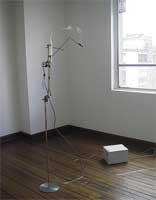

Mademoiselle, Máquina fumadora (Smoking machine)
What fascinates you in the absurd and the useless?
The fact that it is precisely through the absurd and the useless that we can really get to understand what us humans are like: we can perform coherent and beautiful actions that still have no purpose. The purpose of our actions, or even better, their ends, somehow always escapes our comprehension, and yet we keep moving and doing things. It is fascinating then to see, as in a distorted mirror in front of us, what we do, but without our presence: just the action repeating itself over and over.
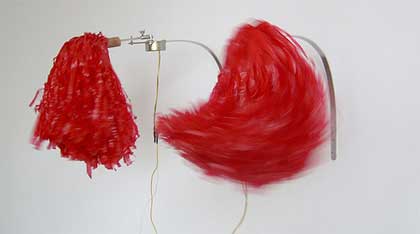
Porristas
What is your relationship with the machines you create? Do you see them as mere objects for galleries or do you develop a more personal relationship with them?
There is something I really like about them: Their design is always the result of very simple mechanical or physical processes, and it is conceived by the mind of an amateur: There is no engineering or high-tech involved. The result is therefore a very personal interpretation of a movement, so it turns to be more an expressive device than a robot or an automatic appliance.
On the other hand there are a couple of pieces that work very well with galleries, but not because they look good in them or because they are commercial. Both the smoking machine (Mademoiselle) and the careless machines (the ones that start making a toast, and end up drunk and unsynchronized) invert the social roles of the actors in an exhibition opening: When the guests drink and smoke while looking at the art pieces, these two art pieces drink and smoke while looking back at their beholders.
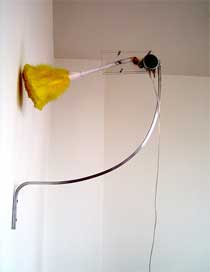
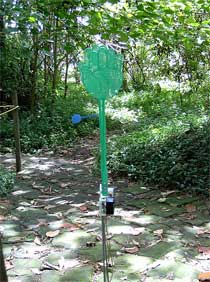
Máquina desempolvadora and La desaparición de las necesidades
How do you develop them? On your own? or do you collaborate with someone else to build up the technical elements?
The whole process of designing and building these objects is rather interesting. I am becoming first of all very comfortable with the fact that they are created in sort of a naïve way. I need to understand what is going on in there, and I need the viewer to do so too, so I tend to avoid complex operations or technologicalological novelties that could leave you just amazed and overwhelmed. Nevertheless, I have always had the support of people that obviously know how to do certain things better than me, especially concerning working with metal or other industrial materials that require special instruments. The rest is just small disco ball motors working!
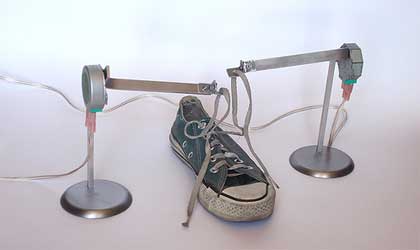
Máquina que intenta amarrar un zapato (Machine that tries to tie shoes)
Are your works a comment on technology, human beings or their relationship to technology? Maybe all of those?
Certainly all of those. I am not a moralist towards technology, but I love to show its ironic side, I love to laugh at the fact that we truly believe technology is progress, and that it is eventually going to save our lives: in my pieces there is always something that remains incomplete, some sort of imperfection that becomes an effective part of the work. It is as if our actions as well as our machines were always failing to succeed their task. Maybe what humanizes our technological world isnât its tendency to boost human form or function, but its constant failure, its fragility.
There is in fact one of my pieces that is actually a âtrying machineâ, a machine that makes an effort and always fails (machine that tries to thread a needle): it is small, modest, and stubborn as a man.
Is there any artists that has influenced you or that you particularly appreciate the work of?
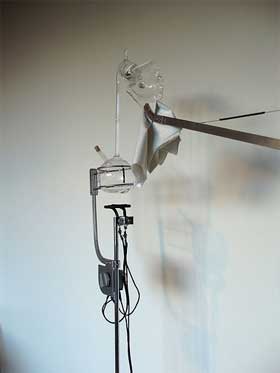
I know I should probably be bringing influential figures here, such as Rebecca Horn or Jean Tinguely, or even Stelarc or Wim Delvoye. I discovered that the artists I love the most are those who are completely alien to my processes and those whose work is most disturbing and uncomprehensible. In the research process for my last piece âlloronaâ (crying woman), for example, I rediscovered some fascinating Man Ray pictures, and I fell in love with Hans Haackeâs Condensation Cube. I also truly related to this last piece in the sense that it is very complex, theatrically complex almost, and at the same time it is the simplest thing of all!!!
What is the reaction of the public when they see your art pieces?
Iâve seen all kinds of reactions. I like the fact that this kind of things tend to escape the discursive, enclosed, and elitist approach to contemporary art. I like, for example, when people laugh at them or when they become interested in how they work or in how they relate to certain human experiences. I had once a group of industrial design students that came with a very unexpected and interesting approach, from the designerâs point of view. I had never thought of my work as design, but I understood that definitely design played a very strong role in it: The human being is able to redesign its body and modify it to perform a certain function, and artists are mostly perception and body designers. I owe this discovery to the input from the public.
Thanks Adriana!
All images courtesy of Adriana Salazar.
Blogged by Hack41
. . . . . . . . . . . . . . . . . . . . . . . . . . . . . . . .

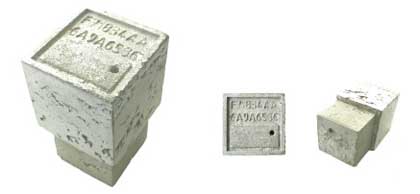

0 Comments:
Post a Comment
<< Home